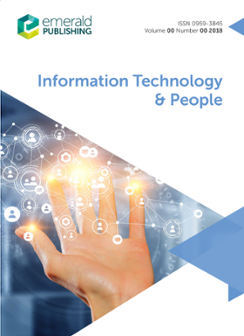Table of contents
Creating value using public big data: comparison of driving factors from the provider's perspective
Ji Yeon Cho, Bong Gyou LeeThe revitalization of big data has gained attention in the public sector. However, such open government data (OGD) is facing major challenges with respect to data quality and…
Predicting popular contributors in innovation crowds: the case of My Starbucks Ideas
Chien-Yi Hsiang, Julia Taylor RayzThis study aims to predict popular contributors through text representations of user-generated content in open crowds.
Job qualifications study for data science and big data professions
Marwah Ahmed Halwani, S. Yasaman Amirkiaee, Nicholas Evangelopoulos, Victor PrybutokThe lack of clarity in defining data science is problematic in both academia and industry because the former has a need for clarity to establish curriculum guidelines in their…
Exploring the relationship between information and communication technology collective behaviors and sense of community: an urban refugee analysis
Richard Canevez, Carleen Maitland, Ying Xu, Sydney Andrea Hannah, Raphael RodriguezHelping others use information and communication technologies (ICTs), such as mobile phones, can be beneficial for individuals and communities. In urban refugee communities…
Analysis of challenges for blockchain adoption within the Indian public sector: an interpretive structural modelling approach
Nripendra P. Rana, Yogesh K. Dwivedi, D. Laurie HughesBlockchain is one of the most significant emerging technologies that is set to transform many aspects of industry and society. However, it has several major technical, social…
Is this real? Cocreation of value through authentic experiential augmented reality: the mediating effect of perceived ethics and customer engagement
Saifeddin Alimamy, Waqar NadeemRapid advancements in augmented reality (AR) technology have created new opportunities for service providers and customers to cocreate value. Using AR as a platform for generating…
E-waste information security protection motivation: the role of optimism bias
Hao Chen, Ofir Turel, Yufei YuanElectronic waste (e-waste) such as discarded computers and smartphones may contain large amounts of confidential data. Improper handling of remaining information in e-waste can…
The dashang feature in social media: a personality and justice theory perspective
Jinlin Wan, Yaobin Lu, Sumeet GuptaDashang refers to a reward given voluntarily to street performers in return for their performance. Some social media platforms have created a way to integrate this as a function…
Reconsidering the digital divide: an analytical framework from access to appropriation
Yvonne Ai-Chi Loh, Arul ChibThis paper presents a framework to measure the digital divide by considering a more comprehensive index of information and communication technology (ICT) predictors. The authors…
Understanding peer recommendation in mobile social games: the role of needs–supplies fit and game identification
Le WangThe purpose of this paper is to understand the antecedents of peer recommendations (generating positive word-of-mouth and recruiting others) in the context of mobile social games.
Do social networking sites promote life satisfaction? The explanation from an online and offline social capital transformation
Lin Huang, Daqing Zheng, Weiguo FanThe use of social networking sites (SNSs) can promote life satisfaction mainly because of their social relationship benefits. Although prior studies examined the roles of…
Shared mental models and perceived proximity: a comparative case study
Efpraxia D. Zamani, Nancy PouloudiThe aim of this study is to understand how virtual teams experience perceived proximity. Existing literature suggests that perceived proximity can be achieved through quality…
Understanding the effects of personality traits on solver engagement in crowdsourcing communities: a moderated mediation investigation
Xiaoxiao Shi, Richard Evans, Wei Pan, Wei ShanCrowdsourcing communities enable companies to post challenges that are completed by solvers (workers); their success depends on engagement, requiring both creativity and effort…
Healthcare workers' communicative constitution of health information technology (HIT) resilience
Ashley K. BarrettAlthough resilience is heavily studied in both the healthcare and organizational change literatures, it has received less attention in healthcare information technology (HIT…
Ensuring employees' information security policy compliance by carrot and stick: the moderating roles of organizational commitment and gender
Chenhui Liu, Huigang Liang, Nengmin Wang, Yajiong XueEmployees’ information security policy (ISP) compliance exerts a significant strain on information security management. Drawing upon the compliance theory and control theory, this…
“Bio to bits”: the Millennium Ecosystem Assessment (MA) as a metaphor for Big Data ecosystem assessment
Sepehr Ghazinoory, Shohreh Nasri, Roya Dastranj, Alfred SarkissianBig Data (BD) is not only a quintessential part of many economic activities but also has evolved into a veritable business ecosystem. However, most Big Data ecosystem (BDE) models…

ISSN:
0959-3845Renamed from:
Office Technology and PeopleOnline date, start – end:
1992Copyright Holder:
Emerald Publishing LimitedOpen Access:
hybridEditors:
- Prof Edgar Whitley
- Prof Kevin Crowston
- Prof Yulin Fang
- Prof Jyoti Choudrie